-
Reagents
- Flow Cytometry Reagents
-
Western Blotting and Molecular Reagents
- Immunoassay Reagents
-
Single-Cell Multiomics Reagents
- BD® OMICS-Guard Sample Preservation Buffer
- BD® AbSeq Assay
- BD® Single-Cell Multiplexing Kit
- BD Rhapsody™ ATAC-Seq Assays
- BD Rhapsody™ Whole Transcriptome Analysis (WTA) Amplification Kit
- BD Rhapsody™ TCR/BCR Next Multiomic Assays
- BD Rhapsody™ Targeted mRNA Kits
- BD Rhapsody™ Accessory Kits
- BD® OMICS-One Protein Panels
- BD OMICS-One™ WTA Next Assay
-
Functional Assays
-
Microscopy and Imaging Reagents
-
Cell Preparation and Separation Reagents
Old Browser
This page has been recently translated and is available in French now.
Looks like you're visiting us from {countryName}.
Would you like to stay on the current location site or be switched to your location?

Lasers and Dyes
Minimize spectral overlap/spread and clearly distinguish cells populations with low antigen density. We offer a wide variety of fluorochromes across multiple lasers line for flow cytometry. To help you choose the right fluorochromes for your experiments, we have developed a fluorochrome atlas that allows you to view and compare dyes with attributes such as excitation/emission spectra, filter recommendations and relative resolution information.
Find details of your fluorochromes from the dye spectra table below.
| Excitation Laser Line | Fluorochrome | Ex-max (nm) | Em-max (nm) | Relative Brightness |
|---|---|---|---|---|
| UV 355 nm |
BD Horizon™ BUV395 | 348 | 395 | |
| BD Horizon™ BUV496 | 350 | 496 | ||
| BD Horizon™ BUV563 | 350 | 564 | ||
| BD Horizon™ BUV615 | 350 | 615 | ||
| BD Horizon™ BUV661 | 350 | 660 | ||
| BD Horizon™ BUV737 | 350 | 735 | ||
| BD Horizon™ BUV805 | 351 | 803 | ||
| Violet 405 nm |
BD Horizon™ BV421 | 407 | 423 | |
| BD Horizon™ V450 | 405 | 450 | ||
| Pacific Blue™ | 404 | 455 | ||
| BD Horizon™ BV480 | 440 | 479 | ||
| BD Horizon™ V500 | 415 | 499 | ||
| BD Horizon™ BV510 | 405 | 512 | ||
| BD Horizon™ BV570** | 407 | 573 | ||
| BD Horizon™ BV605 | 407 | 605 | ||
| BD Horizon™ BV650 | 406 | 649 | ||
| BD Horizon™ BV711 | 407 | 713 | ||
| BD Horizon™ BV75O | 409 | 754 | ||
| BD Horizon™ BV786 | 407 | 786 | ||
| BD Horizon™ RV828 | 412 | 828 | ||
| Blue 488 nm |
BD Horizon™ BB515 | 490 | 515 | |
| Alexa Fluor™ 488 | 494 | 517 | ||
| FITC | 494 | 518 | ||
| BD Horizon™ RB545 | 496 | 545 | ||
| BD Horizon™ RB613 | 492 | 613 | ||
| BD Horizon™ RB670 | 492 | 670 | ||
| PerCP | 481 | 675 | ||
| PerCP-Cy5.5 | 482 | 676 | ||
| BD Horizon™ BB700 | 476 | 695 | ||
| BD Horizon™ RB705 | 498 | 707 | ||
| BD Horizon™ RB744 | 498 | 746 | ||
| BD Horizon™ RB780 | 498 | 781 | ||
| BD Horizon™ RB824 | 492 | 824 | ||
| Yellow-Green 561 nm |
PE* | 566 | 576 | |
| BD Horizon™ RY586 | 564 | 586 | ||
| BD Horizon™ RY610 | 557 | 610 | ||
| BD Horizon™ PE-CF594* | 566 | 615 | ||
| BD Horizon™ RY655 | 557 | 654 | ||
| PE-Cy5* | 566 | 670 | ||
| BD Horizon™ RY703 | 557 | 703 | ||
| BD Horizon™ RY743 | 557 | 743 | ||
| BD Horizon™ RY775 | 557 | 775 | ||
| PE-Cy7* | 566 | 781 | ||
| Red 640 nm |
APC | 651 | 660 | |
| Alexa Fluor™ 647 | 653 | 669 | ||
| BD Horizon™ RR688 | 669 | 688 | ||
| BD Horizon™ APC-R700 | 651 | 706 | ||
| BD Horizon™ Red 718 | 695 | 718 | ||
| Alexa Fluor™ 700 | 697 | 719 | ||
| APC-Cy7 | 651 | 779 | ||
| BD® APC H7 | 659 | 782 |
BUV: BD Horizon Brilliant™ UV; BV: BD Horizon Brilliant™ Violet; V: BD Horizon™ Violet; RV: BD Horizon RealViolet™; BB: BD Horizon Brilliant™ Blue; RB: BD Horizon RealBlue™; RY: BD Horizon RealYellow™; RR: BD Horizon RealRed™.
*Excited by 488-nm, 532-nm and 561-nm lasers.
**Available as custom.
For additional fluorochrome selection support, launch the BD® Spectrum Viewer Tool.
Ultraviolet Laser

BD Horizon™ BUV395
BD Horizon Brilliant™ Ultraviolet 395 (BUV395) (Ex Max 348 nm/Em Max 395 nm) is a UV-excitable dye that has been developed exclusively by BD Biosciences for instruments equipped with a 355 nm UV laser. This dye is optimal for multicolor flow cytometry because it has little to no spillover into other detectors.
Filter: 379/28
Relative brightness: Moderate*

Lysed whole blood stained with CD4 or CD56 in BUV395 or FITC formats
BD Horizon™ BUV496
BD Horizon Brilliant™ Ultraviolet 496 (BUV496) (Ex Max 350 nm/Em Max 496 nm) is a tandem fluorochrome that combines BD Horizon BUV395 and an acceptor dye with an emission maximum at 496 nm. Due to the excitation of the acceptor dye by other laser lines, there may be significant spillover into the channel detecting BD Horizon™ V500 or BV510 (for example, 525/40 nm filter). BUV496 has been exclusively developed by BD Biosciences for instruments equipped with a 355 nm UV laser.
Filter: 515/30
Relative brightness: Moderate*

Lysed whole blood stained with CD4 or CD19 in BUV496 or FITC formats.
FLUOROCHROMES
BD Horizon™ BUV563
BD Horizon Brilliant™ Ultraviolet 563 (BUV563) (Ex Max 350 nm/Em Max 564 nm) is a tandem fluorochrome that combines BD Horizon™ BUV395 and an acceptor dye with an Em Max at 564 nm. Due to the excitation of the acceptor dye by other laser lines, there may be spillover into channels detecting PE (e.g., 575/26 nm filter) and PE-CF594 (e.g., 610/20 nm filter). BUV563 has been exclusively developed by BD Biosciences for instruments equipped with a 355 nm UV laser.
Filter: 560/40 or 585/15
Relative brightness: Bright*
Sample data:

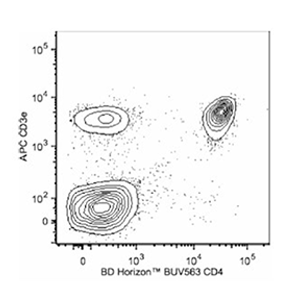
BD Horizon™ BUV615
BD Horizon Brilliant™ Ultraviolet 615 (BUV615) (Ex Max 350 nm/Em Max 615 nm) is part of the BD Horizon Brilliant™ Ultraviolet family of dyes. This tandem fluorochrome is comprised of a BD Horizon™ BUV395 donor with an excitation maximum (Ex Max) of 350 nm and an acceptor dye with an emission maximum (Em Max) at 615 nm. BD Horizon™ BUV615, driven by BD innovation, is designed to be excited by the ultraviolet laser (355 nm) and detected using an optical filter centered near 615 nm (e.g., 610/20 bandpass filter). The acceptor dye can be excited by the blue (488 nm) and yellow-green (561 nm) lasers resulting in cross-laser excitation and fluorescence spillover.
Filter: 610/20
Relative brightness: Bright*
Sample data:

FLUOROCHROMES
BD Horizon™ BUV661
BD Horizon Brilliant™ Ultraviolet 661 (BUV661) (Ex Max 350 nm/Em Max 660 nm) is a tandem dye that combines BUV395 and an acceptor dye with an emission maximum at 660 nm. As part of the BD Horizon Brilliant™ Ultraviolet family, BUV661 provides an additional option for multicolor panels utilizing UV excitable dyes. The acceptor dye can be excited by the red (628–640 nm) laser resulting in cross-laser excitation and fluorescence spillover.
Filter: 670/25
Relative brightness: Bright*
Sample data:
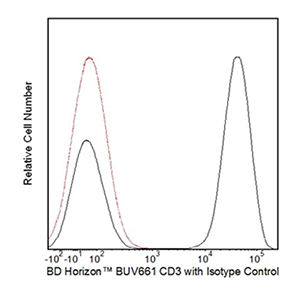
Lysed whole blood stained with Hu CD3 or Hu CD11c BUV661 and appropriate isotype control.


BD Horizon™ BUV737
BD Horizon Brilliant™ Ultraviolet 737 (BUV737) (Ex Max 348 nm/Em Max 737 nm) is a tandem fluorochrome that combines BD Horizon™ BUV395 and an acceptor dye with an emission maximum at 735 nm. Due to the excitation of the acceptor dye by other laser lines, there may be significant spillover into channels detecting dyes with properties like Alexa Fluor™ 700 (for example, 712/20 nm filter). BUV737 has been exclusively developed by BD Biosciences for instruments equipped with a 355 nm UV laser.
Filter: 740/35
Relative brightness: Bright*
Sample data:

Lysed whole blood stained with CD19 or CD127 in BUV737 or FITC formats
BD Horizon™ BUV805
BD Horizon Brilliant™ Ultraviolet 805 (BUV805) (Ex Max 351 nm/Em Max 803 nm) is a tandem fluorochrome that combines BD Horizon™ BUV395 and an acceptor dye with an emission maximum at 803 nm. BUV805 has been exclusively developed by BD Biosciences for instruments equipped with a 355 nm UV laser.
Filter: 820/60 or 780/60
Relative brightness: Dim*
Sample data:

Lysed whole blood stained with CD4 or CD20 BUV805 and appropriate isotype control.
*Relative resolution for each dye was determined based on the average stain index measured across multiple specificities and instruments. Relative resolution and absolute stain index values may change depending on instrument platform and instrument configuration, including lasers, laser power and filters.
Violet Laser
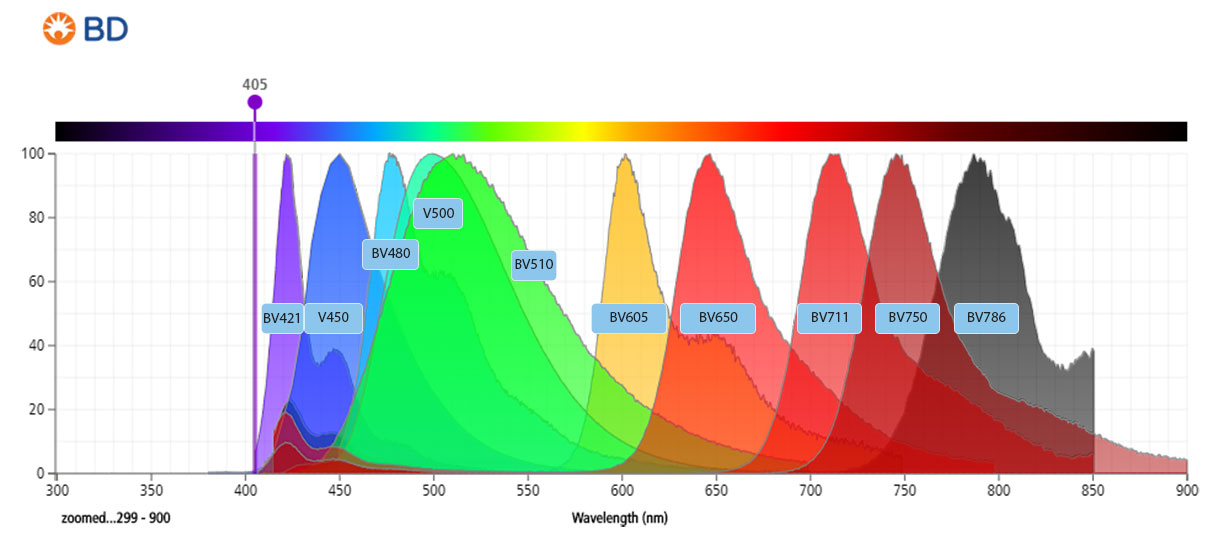
FLUOROCHROMES
BD Horizon™ BV421
BD Horizon Brilliant Violet™ 421 (BV421) (Ex Max 407 nm/Em Max 423 nm) is a polymer-based dye excited by the violet laser and is one of the brightest fluorochromes offered by BD Biosciences. Conjugates are typically 10 times brighter than Pacific Blue™ conjugates and are often as bright as or brighter than PE conjugates. Due to nearly identical excitation and emission properties but different spillover characteristics, BV421, Pacific Blue™ and BD Horizon™ V450 cannot be used simultaneously.
Filter: 431/28 or 450/50
Relative brightness: Very Bright*
Sample data:

Comparison data from two regulatory T cell panels

T cell subset resolved: CD8 memory and effector T cells

T cell subset resolved: CD4 memory and effector T cells

Example data from a 7-color TNK panel
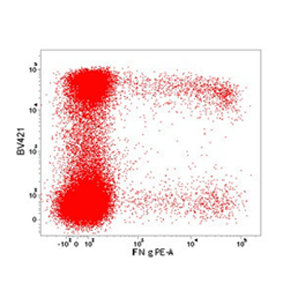
Example of BV421 used in an intracellular staining protocol

Example of BV421 staining using various protocols
FLUOROCHROMES
BD Horizon™ V450
BD Horizon™ Violet 450 (V450) (Ex Max 405 nm/Em Max 450 nm) is part of the BD Horizon™ Violet family of dyes. This is a small organic fluorochrome with an excitation maximum (Ex Max) at 405 nm and an emission maximum (Em Max) at 450 nm. BD Horizon™ V450, driven by BD innovation, is designed to be excited by the violet laser (405 nm) and detected using an optical filter centered near 450 nm (e.g., a 450/50 nm bandpass filter). The dye can be excited by the UV (355 nm) laser resulting in cross-laser excitation and spillover.
Filter: 450/50
Relative brightness: Dim*
BD Horizon™ BV480
BD Horizon Brilliant Violet™ 480 (BV480) (Ex Max 440 nm/Em Max 479 nm) is part of the BD Horizon Brilliant Violet™ family of dyes. This Sirigen base dye is a polymer fluorochrome with an excitation maximum (Ex Max) at 440 nm and an emission maximum (Em Max) at 479 nm. BD Horizon™ BV480, driven by BD innovation, is designed to be excited by the violet laser (405 nm) and detected using an optical filter centered near 480 nm (eg, a 525/50 bandpass filter).
Filter: 525/50
Relative brightness: Bright*
Sample data:

Lysed whole blood stained with Hu CD3, conjugated to BV480 (blue) or BV510 (red)
BD Horizon™ V500
BD Horizon™ Violet 500 (V500) (Ex Max 415 nm/Em Max 499 nm) is part of the BD Horizon™ Violet family of dyes. This is a small organic fluorochrome with an excitation maximum (Ex Max) at 415 nm and an emission maximum (Em Max) at 499 nm. BD Horizon™ V450, driven by BD innovation, is designed to be excited by the violet laser (405 nm) and detected using an optical filter centered near 500 nm (e.g., a 525/50 nm bandpass filter).
Filter: 525/50
Relative brightness: Dim*
Sample Data:

FLUOROCHROMES
BD Horizon™ BV510
BD Horizon Brilliant Violet™ 510 (BV510) (Ex Max 327 nm / 405 nm/Em Max 512 nm) is part of the BD Horizon Brilliant Violet™ family of dyes. This Sirigen base dye is a polymer fluorochrome with an excitation maximum (Ex Max) at 327 nm / 405 nm and an emission maximum (Em Max) at 512 nm. BD Horizon™ BV510, driven by BD innovation, is designed to be excited by the violet laser (405 nm) and detected using an optical filter centered near 510 nm (e.g., a 525/50 bandpass filter). The dye can be excited by the UV (355 nm) laser resulting in cross-laser excitation and spillover. BD Horizon™ BV510 can be detected in the BD Horizon™ V500 (525/50 nm) filter set.
Filter: 525/50
Relative brightness: Moderate*
Sample data:


FLUOROCHROMES
BD Horizon™ BV605
BD Horizon Brilliant Violet™ 605 (BV605) (Ex Max 407 nm/Em Max 605 nm) is a tandem fluorochrome that combines BD Horizon™ BV421 and an acceptor dye. These conjugates are very bright, exhibiting brightness similar to equivalent PE conjugates. Due to the excitation of the acceptor dye by the green (532 nm) and yellow-green (561 nm) lasers, there will be significant spillover of the BV605 signal into the PE and BD Horizon™ PE-CF594 detectors off the green or yellow-green lasers.
Filter: 610/20
Relative brightness: Bright*
Sample data:


FLUOROCHROMES
BD Horizon™ BV650
BD Horizon Brilliant Violet™ 650 (BV650) (Ex Max 406 nm/Em Max 649 nm) is a tandem fluorochrome of BD Horizon™ BV421 and an acceptor dye with an Em Max at 650 nm. Due to the excitation and emission characteristics of the acceptor dye, there will be spillover into the APC and Alexa Fluor™ 700 detectors. BD Horizon™ BV650 will have moderate spillover into the BD Horizon™ BV711 detector.
Filter: 660/20
Relative brightness: Very Bright*
FLUOROCHROMES
BD Horizon™ BV711
BD Horizon Brilliant Violet™ 711 (BV711) (Ex Max 407 nm/Em Max 713 nm) is a tandem fluorochrome of BD Horizon™ BV421 and an acceptor dye with an Em Max at 713 nm. This dye offers a very bright choice for the violet laser. Due to the excitation and emission characteristics of the acceptor dye, there may be moderate spillover into the Alexa Fluor™ 700 and PerCP-Cy5.5 detectors.
Filter: 712/20
Relative brightness: Very Bright*
Sample data:
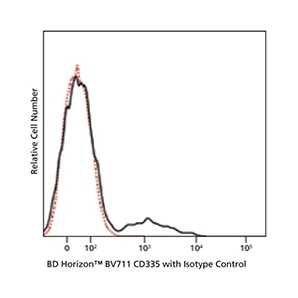

FLUOROCHROMES
BD Horizon™ BV750
BD Horizon Brilliant Violet™ 750 (BV750) (Ex Max 409 nm/Em Max 754 nm) is part of the BD Horizon Brilliant Violet™ family of dyes. This tandem fluorochrome is comprised of a BD Horizon™ BV421 donor with an excitation maximum (Ex Max) of 409 nm and an acceptor dye with an emission maximum (Em Max) at 754 nm. BD Horizon™ BV750, driven by BD innovation, is designed to be excited by the violet laser (405 nm) and detected using an optical filter centered near 750 nm (e.g., a 750/30 nm bandpass filter).
Filter: 750/30
Relative brightness: Moderate*
FLUOROCHROMES
BD Horizon™ BV786
BD Horizon Brilliant Violet™ 786 (BV786) (Ex Max 407 nm/Em Max 786 nm), which is part of the BD Horizon Brilliant Violet™ family of dyes, is a tandem fluorochrome of a BD Horizon™ BV421 donor with an Ex Max of 407 nm and an acceptor dye with an Em Max at 786 nm. BD Horizon™ BV786, driven by BD innovation, is designed to be excited by the violet laser and detected using a filter, centered near 785 nm (e.g., 780/60 nm bandpass filter).
Filter: 780/60
Relative brightness: Bright*
*Relative resolution for each dye was determined based on the average stain index measured across multiple specificities and instruments. Relative resolution and absolute stain index values may change depending on instrument platform and instrument configuration, including lasers, laser power and filters.
Blue Laser

FLUOROCHROMES
BD Pharmingen™ FITC
BD Pharmingen™ FITC (FITC) (Ex Max 494 nm/Em Max 518 nm), fluorescein isothiocyanate, is a fluorochrome with a molecular weight of 389 Da. FITC is sensitive to pH changes and photobleaching. Due to nearly identical excitation and emission properties but different spillover characteristics, FITC and Alexa Fluor™ 488 cannot be used simultaneously. FITC is relatively dim and should be reserved for highly expressed markers whenever possible.
Filter: 530/30
Relative brightness: Moderate*
FLUOROCHROMES
BD Pharmingen™ Alexa Fluor™ 488
BD Pharmingen™ Alexa Fluor™ 488 (Ex Max 494 nm/Em Max 517 nm) conjugates are highly photostable and remain fluorescent over a broad pH range. The excitation and emission maxima are nearly identical to those of FITC. However, Alexa Fluor™ 488 tends to be brighter and more optimal for intracellular applications. Due to nearly identical excitation and emission properties but different spillover characteristics, FITC and Alexa Fluor™ 488 cannot be used simultaneously. Alexa Fluor™ 488 exhibits extraordinary photostability, which makes it highly suitable for fluorescence microscopy.
Filter: 530/30
Relative brightness: Moderate*
FLUOROCHROMES
BD Horizon™ BB515
BD Horizon Brilliant™ Blue 515 (BB515) (Ex Max 490 nm/Em Max 515 nm) is a dye that was exclusively developed by BD Biosciences as a brighter alternative to FITC. This dye is up to seven times brighter than FITC and has less spillover into the PE channel. Due to similar excitation and emission properties, BB515, FITC and Alexa Fluor™ 488 cannot be used simultaneously.
Filter: 530/30
Relative brightness: Very Bright*
Sample data:


FLUOROCHROMES
BD Horizon™ BB630-P2
BD Horizon Brilliant™ Blue 630-P2 (BB630-P2) (Ex Max 476 nm/Em Max 614 nm) is part of the BD Horizon Brilliant™ Blue family of dyes. This tandem fluorochrome is comprised of a Sirigen polymer donor with an excitation maximum (Ex Max) of 476 nm and an acceptor dye with an emission maximum (Em Max) at 614 nm. BD Horizon™ BB630-P2, driven by BD innovation, is designed to be excited by the blue laser (488 nm) and detected using an optical filter centered near 615 nm (e.g., a 616/23 nm bandpass filter). The donor dye can be partially excited by the violet (405 nm) laser resulting in cross-laser excitation and fluorescence spillover.
Filter: 616/23
Relative brightness: Very Bright*
FLUOROCHROMES
BD Horizon™ BB660-P2
BD Horizon Brilliant™ Blue 660-P2 (BB660-P2) (Ex Max 476 nm/Em Max 660 nm) is part of the BD Horizon Brilliant™ Blue family of dyes. This tandem fluorochrome is comprised of a Sirigen polymer donor with an excitation maximum (Ex Max) of 476 nm and an acceptor dye with an emission maximum (Em Max) at 660 nm. BD Horizon™ BB630-P2, driven by BD innovation, is designed to be excited by the blue laser (488 nm) and detected using an optical filter centered near 660 nm (e.g., a 660/20 nm bandpass filter). The donor dye can be partially excited by the violet (405 nm) laser and the acceptor dye can be excited by the red laser (627–640 nm) resulting in cross-laser excitation and fluorescence spillover.
Filter: 660/20
Relative brightness: Very Bright*
BD Horizon™ BB700
BD Horizon Brilliant™ Blue 700 (BB700) (Ex Max 476 nm/Em Max 695 nm) is a dye that was exclusively developed by BD Biosciences as a brighter alternative to PerCP-Cy5.5, making it better suited for resolving dim populations. This dye also has less cross laser excitation off the 405 nm laser, resulting in less spillover into the violet channels compared to PerCP-Cy5.5. Due to similar excitation and emission properties, BD Horizon™ BB700 and PerCP-Cy5.5 cannot be used simultaneously.
Filter: 695/40
Relative brightness: Very Bright*
FLUOROCHROMES
BD Pharmingen™ PerCP
BD Pharmingen™ PerCP (PerCP) (Ex Max 481 nm/Em Max 675 nm) is a component of the photosynthetic apparatus found in the dinoflagellate Glenodinium. PerCP is a protein complex with a molecular weight of approximately 35 kDa. Due to its photobleaching characteristics, PerCP conjugates are not recommended for use on flow cytometers with high-power lasers (>25 mW). PerCP is designed to be excited by the blue laser (488 nm) and detected using an optical filter centered near 680 nm (e.g., a 695/40 nm bandpass filter). The donor dye can be partially excited by the violet (405 nm) laser resulting in cross-laser excitation and fluorescence spillover.
Filter: 695/40
Relative brightness: Dim*
FLUOROCHROMES
BD Pharmingen™ PerCP-Cy5.5
BD Pharmingen™ PerCP-Cy5.5 (PerCP-Cy5.5) (Ex Max 482 nm/Em Max 676 nm) is a tandem conjugate that combines PerCP with a cyanine dye. PerCP-Cy5.5 is not subject to photobeaching like PerCP and can be used with stream-in-air flow cytometers. It has less Fc receptor-mediated nonspecific staining than PE-Cy5. PerCP-Cy5 is designed to be excited by the blue laser (488 nm) and detected using an optical filter centered near 680 nm (e.g., a 695/40 nm bandpass filter). The donor dye can be partially excited by the violet (405 nm) laser resulting in cross-laser excitation and fluorescence spillover. Additionally, the PerCP-Cy5.5 tandem conjugate is not as susceptible to fixative or light instability as APC-Cy7 and PE-Cy7.
Filter: 695/40
Relative brightness: Moderate*
FLUOROCHROMES
BD Horizon™ BB755-P
BD Horizon Brilliant™ Blue 755-P (BB755-P) (Ex Max 478 nm/Em Max 755 nm) is part of the BD Horizon Brilliant™ Blue family of dyes. This tandem fluorochrome is comprised of a Sirigen polymer donor with an excitation maximum (Ex Max) of 478 nm and an acceptor dye with an emission maximum (Em Max) at 755 nm. BD Horizon™ BB755-P, driven by BD innovation, is designed to be excited by the blue laser (488 nm) and detected using an optical filter centered near 755 nm (e.g., a 750/50 nm bandpass filter). The donor dye can be partially excited by the violet (405 nm) laser and the acceptor dye can be excited by the red (627–640) laser resulting in cross-laser excitation and fluorescence spillover.
Filter: 750/50
Relative brightness: Bright*
FLUOROCHROMES
BD Horizon™ BB790-P
BD Horizon Brilliant (Ex Max 484 nm/Em Max 790 nm) is part of the BD Horizon Brilliant™ Blue family of dyes. This tandem fluorochrome is comprised of a Sirigen polymer donor with an excitation maximum (Ex Max) of 484 nm and an acceptor dye with an emission maximum (Em Max) at 790 nm. BD Horizon BB790-P, driven by BD innovation, is designed to be excited by the blue laser (488 nm) and detected using an optical filter centered near 790 nm (e.g., a 800/60 nm bandpass filter). The donor dye can be partially excited by the violet (405 nm) laser resulting in cross-laser excitation and fluorescence spillover.
Filter: 800/60
Relative brightness: Very Bright*
*Relative resolution for each dye was determined based on the average stain index measured across multiple specificities and instruments. Relative resolution and absolute stain index values may change depending on instrument platform and instrument configuration, including lasers, laser power and filters.
Yellow Green Laser

FLUOROCHROMES
BD Horizon RealYellow™ 586 Reagents
BD Horizon RealYellow™ 586
561-nm
565-nm ExMax
586-nm EmMax
4 Relative Resolution
Small molecule organic dye - Dye type
The BD Horizon RealYellow™ 586 (RY586) Dye is part of the BD family of yellow-green dyes. It is a small organic fluorochrome with an excitation maximum (Ex Max) at 565-nm and an emission maximum (Em Max) at 586-nm. Driven by BD innovation, RY586 can be used on both spectral and conventional cytometers and is designed to be excited by the Yellow-Green laser (561-nm) with minimal excitation by the 488-nm Blue laser. For conventional instruments equipped with a Yellow-Green laser (561-nm), RY586 can be used as an alternative to PE and we recommend using an optical filter centered near 586-nm (eg, a 586/15-nm bandpass filter). For spectral instruments equipped with a Yellow-Green laser (561-nm), it can be used in conjunction with PE. Compared to PE, RY586 is similar in brightness, minimal spillover into Blue detectors, and increased spillover into the 610/20-nm (PE-CF594) detector. Please ensure that your instrument configuration (lasers and optical filters) is appropriate for this dye.
FLUOROCHROMES
BD Horizon™ BYG584
BD Horizon Brilliant™ Yellow-Green 584 (BYG584) (Ex Max 563 nm/Em Max 583 nm) is part of the BD Horizon Brilliant™ Yellow-Green family of dyes. This dye is a polymer fluorochrome with an excitation maximum (Ex Max) at 563 nm and an emission maximum (Em Max) at 583 nm. BD Horizon™ BYG584, driven by BD innovation, is designed to be excited by the yellow-green laser (561 nm) and detected using an optical filter centered near 585 nm (e.g., 585/29 nm bandpass filter).
Filter: 585/29
Relative brightness: Very Bright*
FLUOROCHROMES
BD Pharmingen™ PE
BD Pharmingen™ PE (Ex Max 496 nm and 566 nm /Em Max 576 nm), R-phycoerythrin (PE), is an accessory photosynthetic pigment found in red algae. It exists in vitro as a 240-kDa protein with 23 phycoerythrobilin chromophores per molecule. PE is designed to be excited by the blue (488 nm), green (532 nm) and yellow-green (561 nm) lasers and detected using an optical filter centered near 575 nm (e.g., a 575/26 nm bandpass filter). As PE is excited by multiple lasers, this can result in cross-laser excitation and fluorescence spillover on instruments with various combinations of blue, green and yellow-green lasers.
Filter: 575/26
Relative brightness: Very Bright*
FLUOROCHROMES
BD Horizon™ PE-CF594
BD Horizon™ PE-CF594 (PE-CF594) (Ex Max 496 nm and 566 nm/Em Max 615 nm) is a tandem conjugate that combines PE and CF594. PE-CF594, driven by BD innovation, is designed to be excited by the blue (488 nm), green (532 nm) and yellow-green (561 nm) lasers and detected using an optical filter centered near 615 nm (e.g., a 610/20 nm bandpass filter). The donor dye can be excited by the blue (488 nm), green (532 nm) and yellow-green (561 nm) lasers and the acceptor dye can be excited by the green (532 nm) laser resulting in cross-laser excitation and fluorescence spillover. PE-CF594 is a brighter alternative to PE-Texas Red, with improved spectral characteristics. PE-CF594 reagents exhibit very consistent spillover values lot-to-lot, making them an ideal choice for the PE-Texas Red detector (610/20 nm).
Filter: 610/20
Relative brightness: Very Bright*
Sample data:




FLUOROCHROMES
BD Pharmingen™ PE-Cy5
BD Pharmingen™ PE-Cy5 (PE-Cy5) (Ex Max 496 nm and 566 nm/Em Max 670 nm) is a tandem conjugate that combines phycoerythrin and a cyanine dye. PE designed to be excited by the blue (488 nm), green (532 nm) and yellow-green (561 nm) lasers and detected using an optical filter centered near 670 nm (e.g., a 670/20 nm bandpass filter). The donor dye can be excited by the blue (488 nm), green (532 nm) and yellow-green (561 nm) lasers and the acceptor dye can be excited by the red (627-640 nm) laser resulting in cross-laser excitation and fluorescence spillover. Because of its broad absorption range and the fact that its emission spectrum is equivalent to APC, PE-Cy5 is not recommended for simultaneous use with APC. The Cy5 molecule has been shown to exhibit nonspecific binding to Fc receptors, which is most apparent on monocyte populations. PE-Cy5 is not recommended for fluorescence microscopy because it is subject to photobleaching.
Filter: 670/20
Relative brightness: Very Bright*
FLUOROCHROMES
BD Pharmingen™ PE-Cy7
BD Pharmingen™ PE-Cy7 (PE-Cy7) (Ex Max 496 nm and 566 nm/Em Max 781 nm) is a tandem fluorochrome that combines PE and a cyanine dye. PE can be excited by the blue (488 nm), green (532 nm) and yellow-green (561 nm) lasers and detected using an optical filter centered near 781 nm (e.g., a 760/60 nm bandpass filter). The donor dye can be excited by the blue (488 nm), green (532 nm) and yellow-green (561 nm) lasers and the acceptor dye can be excited by the red (627-640 nm) laser resulting in cross-laser excitation and fluorescence spillover. PE-Cy7 conjugated reagents are as bright as PE conjugates. PE-Cy7 is particularly sensitive to photo-induced degradation, resulting in loss of fluorescence and changes in fluorescence spillover. Extreme caution must be taken to avoid light exposure and prolonged exposure to paraformaldehyde fixative. Fixed cells should be analyzed within 4 hours of fixation in paraformaldehyde or transferred to a paraformaldehyde-free buffer for overnight storage.
Filter: 760/60
Relative brightness: Very Bright*
*Relative resolution for each dye was determined based on the average stain index measured across multiple specificities and instruments. Relative resolution and absolute stain index values may change depending on instrument platform and instrument configuration, including lasers, laser power and filters.
Red Laser
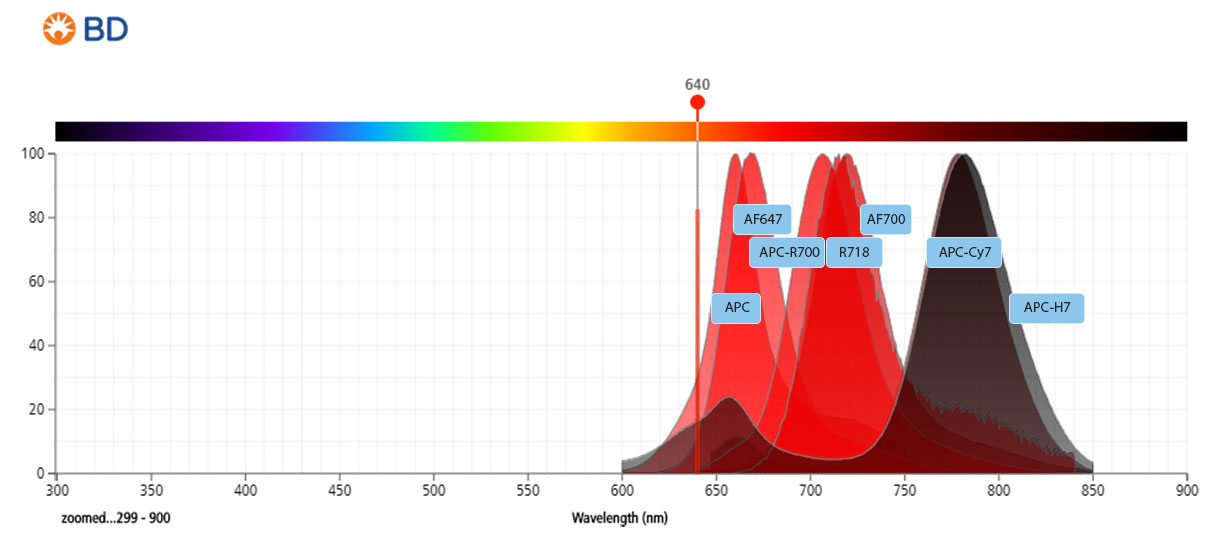
FLUOROCHROMES
BD Pharmingen™ APC
Allophycocyanin (APC) (Ex Max 651 nm/Em Max 660 nm) is an accessory photosynthetic pigment found in blue-green algae. Its molecular weight is approximately 105 kDa. APC has six phycocyanobilin chromophores per molecule, which make it a very bright fluorochrome that is highly suitable for flow cytometry applications. APC is designed to be excited by the red (627–640 nm) laser and detected using an optical filter centered near 660 nm (e.g., a 660/20 nm bandpass filter). Due to nearly identical excitation and emission properties but different spillover characteristics, APC and Alexa Fluor™ 647 cannot be used simultaneously.
Filter: 660/20
Relative brightness: Bright*
FLUOROCHROMES
BD Pharmingen™ Alexa Fluor™ 647
BD Pharmingen™ Alexa Fluor™ 647(Ex Max 653 nm/Em Max 669 nm) conjugates are highly photostable and remain fluorescent over a broad pH range. Alexa Fluor™ 647 is designed to be excited by the red laser (627–640 nm) and detected using an optical filter centered near 520 nm (e.g., a 660/20 nm bandpass filter). The excitation and emission maxima are nearly identical to those of APC. However, APC tends to be brighter while Alexa Fluor™ 647 is more optimal for intracellular applications. This fluorochrome exhibits uncommon photostability, making it an ideal choice for use in fluorescence microscopy. Due to nearly identical excitation and emission properties but different spillover characteristics, APC and Alexa Fluor™ 647 cannot be used simultaneously.
Filter: 660/20
Relative brightness: Bright*
BD Horizon™ APC-R700
BD Horizon™ APC-R700 (APC-R700) (Ex Max 651 nm/Em Max 706 nm) is a tandem fluorochrome that combines APC with R700, a proprietary organic dye. It has an excitation maximum (Ex Max) of 651 nm and an emission maximum (Em Max) at 706 nm. This dye has been developed exclusively by BD Biosciences as a brighter alternative to Alexa Fluor™ 700. APC-R700 is designed to be excited by the red (627–640 nm) laser and detected using an optical filter centered near 710 nm (e.g., a 720/40 nm bandpass filter).
Filter: 720/40
Relative brightness: Bright*
Sample Data:

Cells stained with APC-R700 show a large spread between positive and negative populations similar to cells stained with PE
FLUOROCHROMES
BD Pharmingen™ Alexa Fluor™ 700
BD Pharmingen™ Alexa Fluor™ 700 (Ex Max 697 nm/Em Max 719 nm) is designed to be excited by the red (627–640 nm) laser and detected using an optical filter centered near 720 nm (e.g., a 720/40 nm bandpass filter). This enables multicolor analysis in conjunction with APC and Alexa Fluor™ 647; or APC-H7 and APC-Cy7 reagents.
Filter: 720/40
Relative brightness: Dim*
FLUOROCHROMES
BD Horizon™ R718
BD Horizon™ Red 718 (R718) (Ex Max 695 nm/Em Max 718 nm) is part of the BD Horizon™ Red family of dyes. This is a small organic fluorochrome with an excitation maximum (Ex Max) at 695 nm and an emission maximum (Em Max) at 718 nm. R718, driven by BD innovation, is designed to be excited by the red laser (627–640 nm) and detected using an optical filter centered near 720 nm (e.g., a 720/40 nm bandpass filter).
Filter: 720/40
Relative brightness: Bright*
Sample data:


FLUOROCHROMES
BD Pharmingen™ APC-Cy7
BD Pharmingen™ APC-Cy7 (APC-Cy7) (Ex Max 651 nm/Em Max 782 nm) is a tandem fluorochrome that combines APC and a cyanine dye (Cy7). APC-Cy7 can be excited by the red (627–640 nm) laser and detected using an optical filter centered near 780 nm (e.g., a 760/60 nm bandpass filter). Special precautions must be taken with APC-Cy7 conjugates and cells stained with them to protect the fluorochrome from long-term exposure to light. Some APC-Cy7 conjugates show changes in their emission spectra with prolonged exposure to paraformaldehyde. Fixed cells should be analyzed within 4 hours of fixation in paraformaldehyde or transferred to a paraformaldehyde-free buffer for overnight storage.
Filter: 760/60
Relative brightness: Dim*
BD Pharmingen™ APC-H7
BD Pharmingen™ APC-H7 (ACP-H7) (Ex Max 659 nm/Em Max 782 nm) is an APC-cyanine tandem fluorochrome, which uses an analog of Cy7 and has similar spectral properties to APC-Cy7. APC-H7 is designed to be excited by the red (627–640 nm) laser and detected using an optical filter centered near 780 nm (e.g., a 760/60 nm bandpass filter). APC-H7 conjugates provide greater stability in light and paraformaldehyde fixatives and have less spillover into the APC channel than APC-Cy7 conjugates. APC-H7 conjugates are typically 75% as bright as equivalent APC-Cy7 conjugates. Due to nearly identical excitation and emission properties but different spillover characteristics, APC-Cy7 and APC-H7 cannot be used simultaneously.
Filter: 760/60
Relative brightness: Dim*
Sample data:

*Relative resolution for each dye was determined based on the average stain index measured across multiple specificities and instruments. Relative resolution and absolute stain index values may change depending on instrument platform and instrument configuration, including lasers, laser power and filters.
APC-Cy7: US Patent 5,714,386
For Research Use Only. Not for use in diagnostic or therapeutic procedures.
Pacific Blue, Alexa Fluor and Texas Red are trademarks of Life Technologies Corporation.
Cy is a trademark of Global Life Sciences Solutions Germany GmbH or an affiliate doing business as Cytiva.
CF is a trademark of Biotium, Inc.